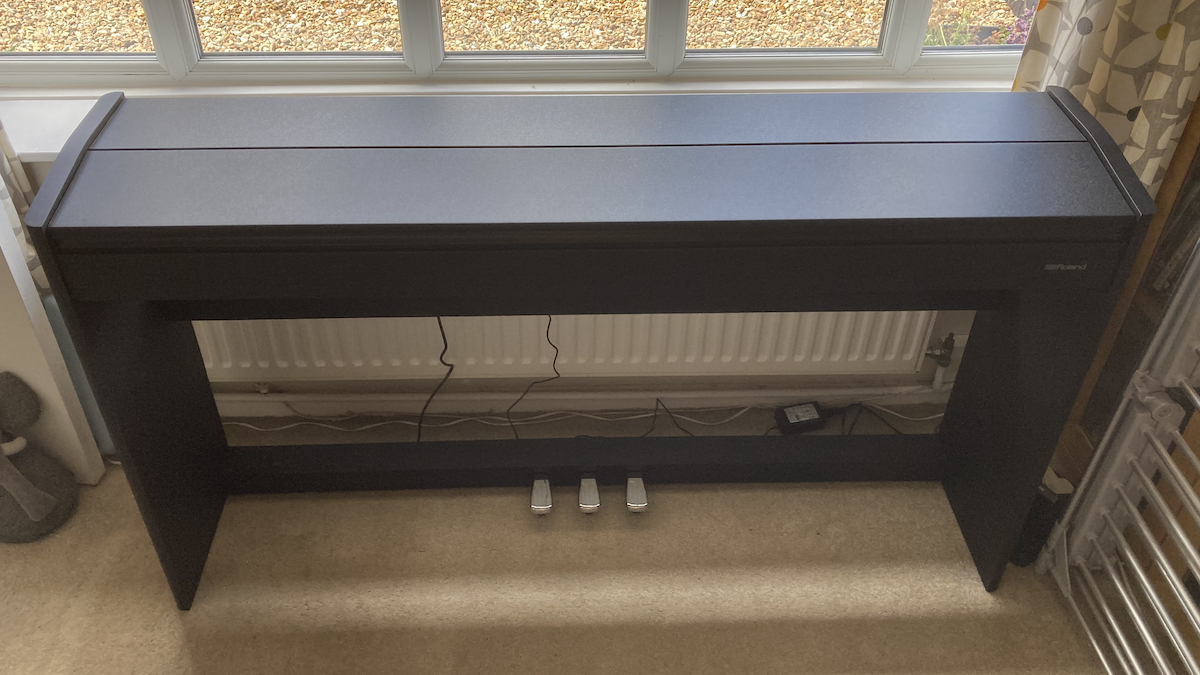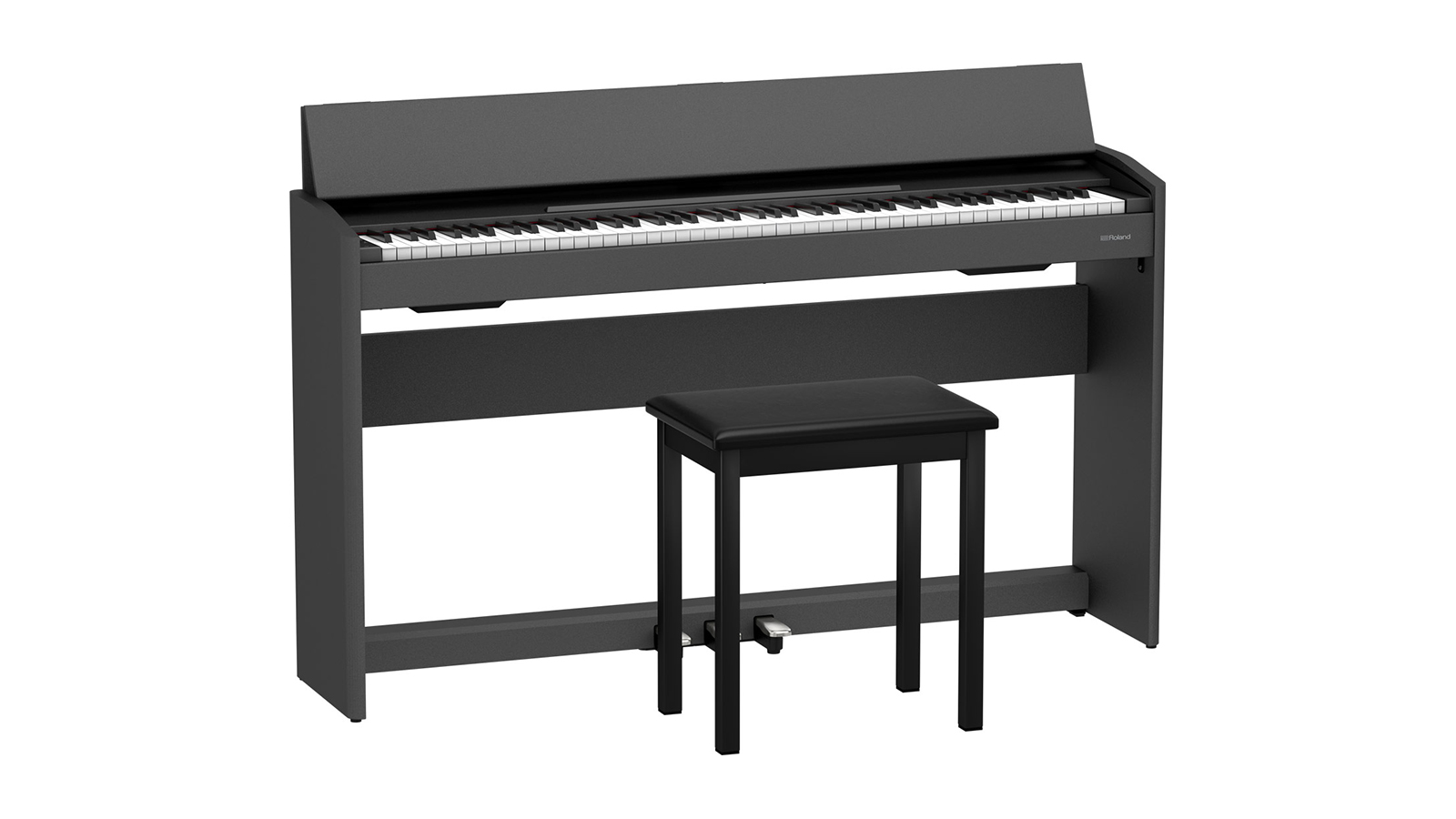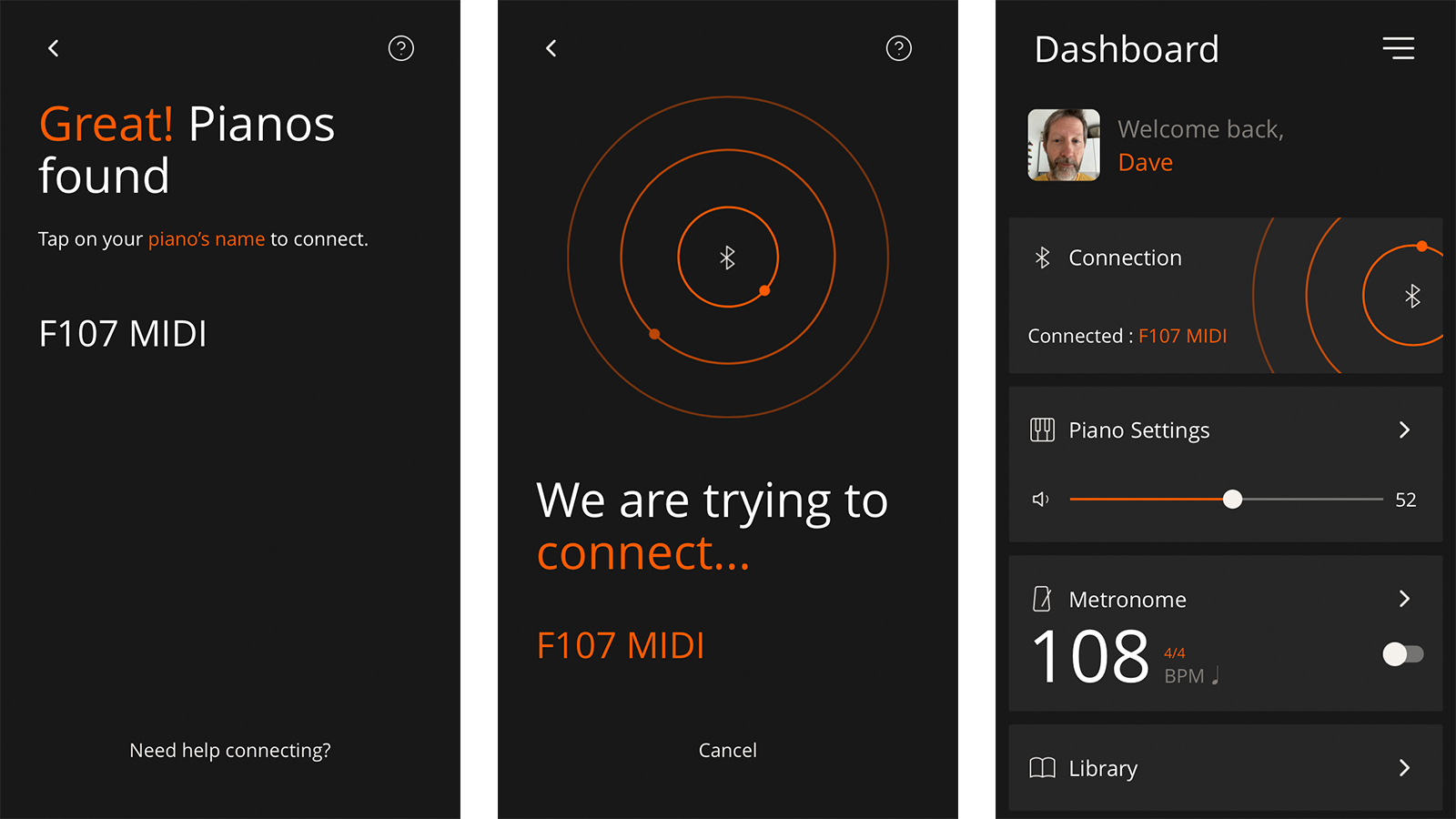MusicRadar Verdict
The F107 is a compact, stylish and affordable instrument with a wonderfully playable keyboard, hampered by boxy speakers and an over-simplified user interface.
Pros
- +
Fantastic key action
- +
Compact footprint
- +
Elegant design
Cons
- -
Inscrutable interface
- -
Needs the Roland Piano app for best results
- -
Slightly boxy speakers
MusicRadar's got your back
Roland F107 review: What is it?
One of a pair of new slimline, entry-level digital pianos from Roland - the other being the slightly more traditionally-styled RP107 - the F107 is one of the most diminutive console-style home pianos we’ve come across. With a footprint it’s hard to imagine could be any more compact, the F107 should fit comfortably anywhere from the tiniest of apartments to the most generous studio or living room space.
With a textured matt-black finish to the cabinet, we’d describe the overall design of the F107 as contemporary with an understated elegance. The folding keyboard cover lifts up and turns into a music desk that runs the full width of the instrument, handy for resting iPads, music books, phones and the like. To the left of the keyboard sits a minimalist control panel, sporting just four flush-mounted buttons, one for powering on and off, two for adjusting volume, and the last for entering settings mode.
At floor level, the full complement of three chrome-finished pedals - damper, sostenuto and soft - are slightly squared-off in a modern yet elegant design, and all three work as expected, connected with a single cable to a socket on the underside of the keyboard unit. Also on the underside, you’ll find the two USB ports plus dual headphone sockets to facilitate student/teacher interaction under headphone conditions, so you'll need to feel around for them when needed.
The F107 comes packed in a large, heavy cardboard box, so some self-assembly is required - you’ll need two of you to put the piano together, and there’s a fair bit of crawling around on the floor to do. It’s a simple enough task, involving just twelve screws, and although it only took us about 45 minutes to build, you’ll need plenty of space for the job, much more than for the finished item itself.
Roland F107 review: Performance & verdict



Once assembled, the F107’s wake-up time from power-off to playable is better than most - push the on button and you’ll be ready to play in a mere three seconds. Roland has deployed its PHA-4 Standard keyboard action on this model, which with its faux-ivory key tops feels great to play. The action is moderately weighty, enough to give beginners a challenge while satisfying more experienced players with an authentic pianistic feel. Which leads us to how this piano actually sounds.
Although apparently derived from the same SuperNATURAL engine used in their more expensive instruments, we found the default grand piano sound a little on the boxy side in the midrange. Roland don’t state what make of acoustic piano this sound is modelled on, but to our ears it veers more towards the warm, rounded-off tone of a Bosendorfer than the bright sparkliness of a Yamaha.
Mellow and bright versions of the grand piano tone are also included, but they also seemed to suffer from a mid-range honkiness. Things did improve a little when we tried it with digital piano headphones, which suggests that the speakers might be a contributing factor. Beginner digital pianos don’t tend to offer the refined, multi-speaker arrays found in higher-end instruments and, downward-firing and situated on the underside of the keyboard unit towards the rear, the F107’s speakers appear to be one area in which the money-saving has hit the hardest.
Want all the hottest music and gear news, reviews, deals, features and more, direct to your inbox? Sign up here.
Interface of it

The F107 is a budget instrument aimed at beginners, and as such we get that production costs need to be kept a keen eye on. When you have an instrument with 88 keys, it’s obviously tempting to have them double up as function switches and use a single Settings button to access the instrument’s parameters.
And this is the thing. On the F107, literally every single one of the 88 keys has been assigned a function, from voice selection to changing the tempo of the metronome, even selecting the built-in songs, so whatever you do, don’t lose that manual! It also makes each parameter change a two-handed, hunt-and-peck affair. Roland call this a ‘simple and direct user interface for easy operation’, but we'd have preferred at least a pair of buttons to scroll through the available tones, as found on the Yamaha Arius YDP-145. With no display, there's also no visual feedback to tell you whether you have the Concert, Bright or Mellow grand piano tone - or even any other of the 15 onboard tones - selected.
We can’t help feeling that hobbling an instrument’s interface under the guise of maintaining an elegant piano aesthetic is hiding its light under a bushel somewhat. On numerous occasions when seated at the F107, we would have liked to attempt a parameter change or access a function, but didn’t because we didn’t have the manual to hand to remind us which key to press. It seems that the F107 has been designed very much with the addition of an external iOS device in mind.
Well connected

Yamaha Arius YDP-145
Yamaha’s take on the low-profile console-style digital beginner’s piano.
Casio Celviano AP270
Entry-level Celviano with a contemporary design and European and American piano tones.
Roland pianos always score highly on Bluetooth connectivity, and the F107 is no exception. As well as full compatibility with the newly updated and renamed Roland Piano app, there’s also Bluetooth audio and MIDI support. Bluetooth audio allows you to stream music from your mobile devices through the piano's speakers so that you can play along. Meanwhile, Bluetooth MIDI means you can use the F107 as a wireless MIDI controller keyboard with DAWs such as GarageBand, Logic, Ableton Live or FL Studio.
In practice, the F107’s Bluetooth features work very well, transforming the way in which you work with the instrument through the addition of your own mobile device. The Roland Piano app guides you step-by-step through the setup process, and you’ll need to create a RolandCloud account if you don’t already have one. After that, you’ll be able to connect wirelessly to the F107 and control all its sounds and settings remotely, access a bunch of extra GM sounds, change the metronome settings, browse songs from the onboard library and call up the sheet music to learn them or play along, record your performances with the built-in song recorder, play along using auto-accompaniment, use flashcards as training exercises, use the ‘One Week Master’ feature to learn a new piece in seven days and a lot more.
Offering the ability to toss away the manual, dive under the hood of your formerly inscrutable piano and finally get to all those hidden sounds and settings, it’s safe to say that using the app transforms the user experience with the F107 from a bit of a head-scratcher to a proper crowd-pleaser.
Roland F107 review: Hands-on demos
Sam Ash
Rimmers Music
Roland F107 review: Specification
- Keys: PHA-4 standard keyboard with 88 individually weighted keys with escapement and synthetic ivory key tops
- Weight: 34.5kg
- Dimensions (W x D x H)mm: 1360 x 345 x 778
- Speakers: 2 x 12cm, 8W
- Pedals: Damper, Sostenuto, Soft - Damper and Soft capable of continuous detection
- Connections: 1 x 6.3mm headphone output, 1 x 3.5mm headphone output, USB to host, USB to device, Bluetooth audio and MIDI
- Tones: 15
- Polyphony: 256
- Contact: Roland
Dave has been making music with computers since 1988 and his engineering, programming and keyboard-playing has featured on recordings by artists including George Michael, Kylie and Gary Barlow. A music technology writer since 2007, he’s Computer Music’s long-serving songwriting and music theory columnist, iCreate magazine’s resident Logic Pro expert and a regular contributor to MusicRadar and Attack Magazine. He also lectures on synthesis at Leeds Conservatoire of Music and is the author of Avid Pro Tools Basics.

